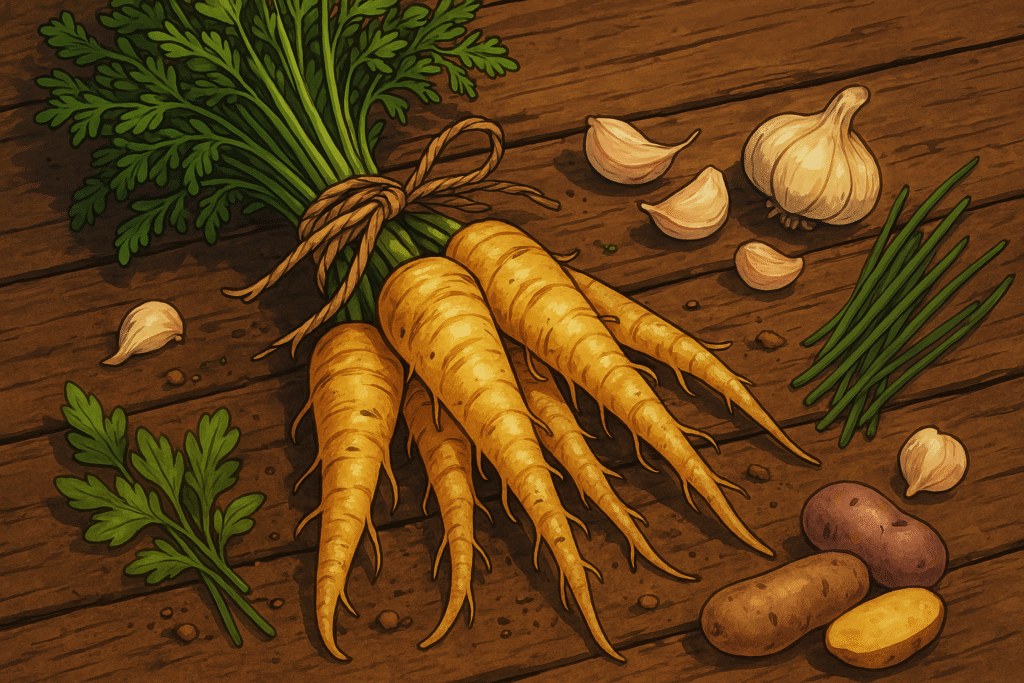Parsnip (Pastinaca sativa)

About Parsnip
Parsnips are winter’s answer to sweetness — earthy, nutty, and caramel-like when roasted. Though often overshadowed by their orange cousin, the carrot, parsnips bring bold personality to purées, soups, fries, and even baked goods.
Their ivory skin and tapered shape may seem humble, but their ability to develop intense flavor in cold soil has made them a cold-weather staple for centuries.
The History of Parsnip
Parsnips were a dietary cornerstone long before the potato arrived in Europe. Native to Eurasia, they were cultivated by the Romans, who believed they had medicinal properties and aphrodisiac effects. In medieval Europe, they were one of the main sources of starch and sweetness.
They remained popular until the 18th century when potatoes became dominant. Still, in Northern and Eastern Europe — especially in British, Irish, and Polish cuisines — parsnips retained their place in roasts, stews, and holiday tables.
The Science of Parsnip
Parsnips are high in natural sugars, which concentrate when exposed to frost. This triggers the plant to convert starch into sugar, giving that sweet, roasted edge unique to winter-harvested roots.
They contain polyacetylenes, which give a slight peppery or spicy flavor and may have antioxidant properties. Their texture is dense and slightly fibrous, especially near the core of large roots.
The Geography of Parsnip
arsnips thrive in temperate climates and sandy soil. They’re a cold-climate crop that benefits from frost exposure, which boosts sweetness. You’ll find them grown across the UK, northern Europe, Canada, and the northern U.S.
In warmer areas, parsnips often struggle — too much heat leads to tough texture and bland taste. In places like Scandinavia and the Baltics, they’re a beloved winter vegetable.
Varieties of Parsnip
Hollow Crown
A heritage variety with a long, tapered shape and rich, nutty flavor. Great for traditional roasting.
Gladiator
A modern cultivar known for its disease resistance and high yields. Sweet and smooth-fleshed.
Tender and True
Award-winning flavor with a classic shape. Ideal for purées and soups due to its fine texture.
White Gem
Shorter and stubbier, excellent for shallow soils. Offers concentrated sweetness and fewer fibers.
Javelin
Early maturing and reliable in variable weather. Popular with commercial growers.
FAQs All your questions about Parsnip: answered
Do parsnips need to be peeled?
Not always. Young parsnips can be scrubbed clean and cooked with skin on. Older or thicker roots benefit from peeling to remove bitterness.
Are parsnips sweet or savory?
Both — they have a naturally sweet flavor that shines when roasted, but also work well in savory soups and broths.
Can you eat parsnips raw?
Yes, though they’re more fibrous and slightly spicy when raw. Thin slices can be shaved into salads or slaws.
What’s the difference between parsnips and carrots?
Parsnips are paler, sweeter, and spicier. Carrots are more crisp and earthy. They can often be used interchangeably but offer distinct flavors.